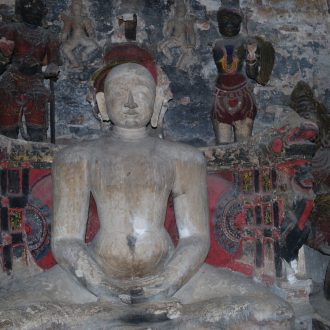A day exploring Gwalior Fort, Madhya Pradesh
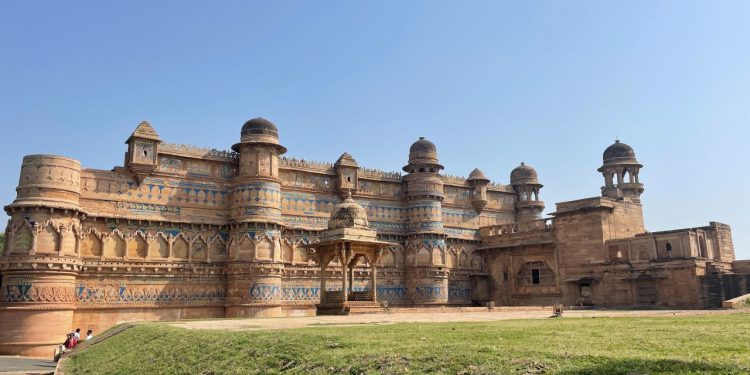
There are over six layers of history to this medieval fortress” said archaeologist Padma Shri KK Muhammad Sir as we stood at the foot of the towering Gwalior Hill Fort in Madhya Pradesh, admiring the glazed blue tiles sparkling on the ochre facade of the fortress. It is a bright sunny morning with blue cloudless skies and the fortress is a sheer showstopper with the walls soaring to almost 10 metres . The motifs on the outer walls of the Gwalior Fort are fascinating, as they stand out painted in various shades of yellow and blue. Just above the Toranas is a row of yellow ducks standing out in the sandstone while crocodiles and elephants adorn the walls.
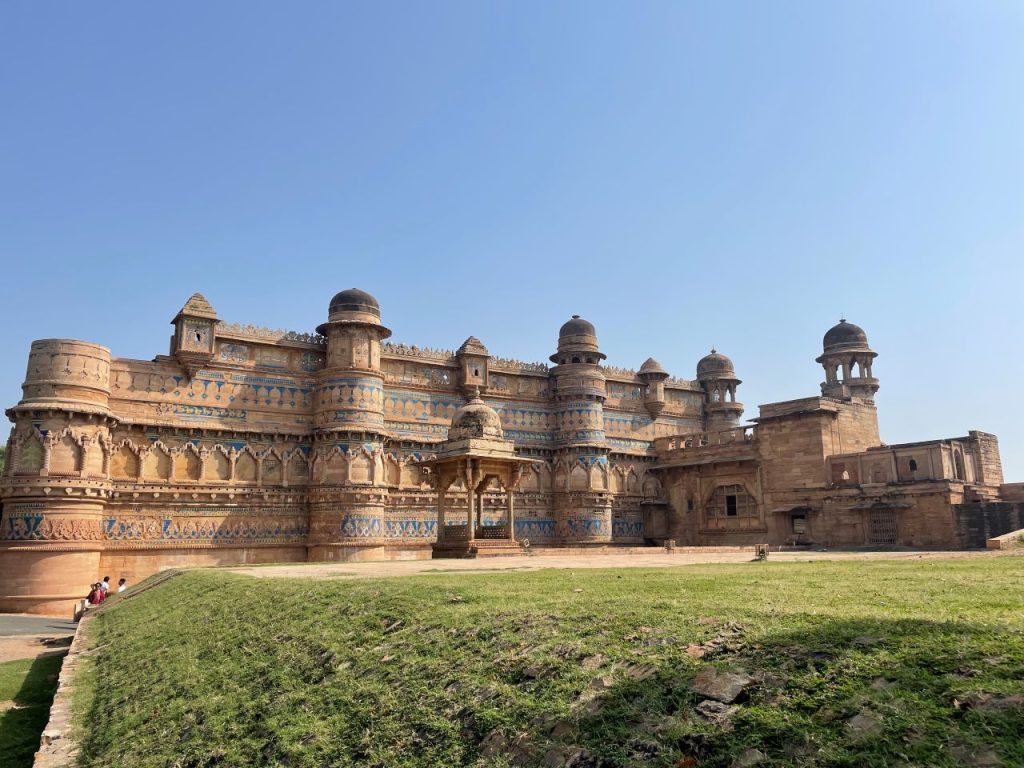
KK Muhammad Sir continues with the history class as we huddle around the renowned archaeologist, ” The first layer goes back to the 6th century when Mihirakula of the Huna Dynasty ruled over here briefly. Then came the Gurjara Pratihara Dynasty followed by the Kachchhapaghatas who reigned between the 8th-10th centuries, according to various inscriptions in the Gwalior fort complex.
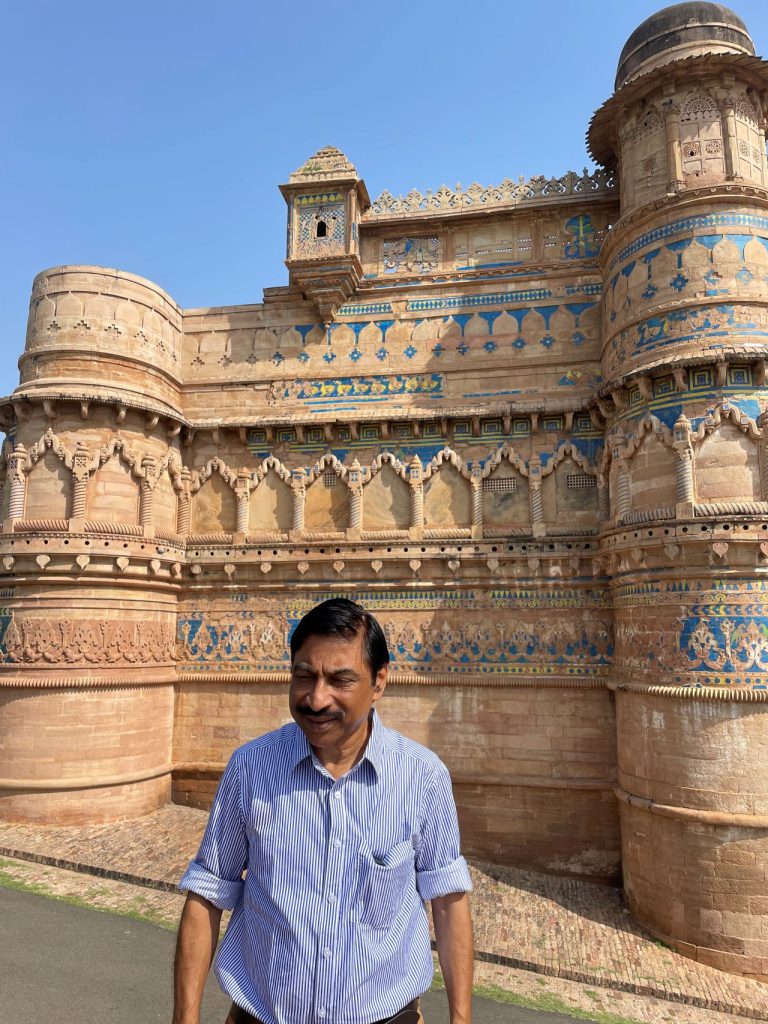
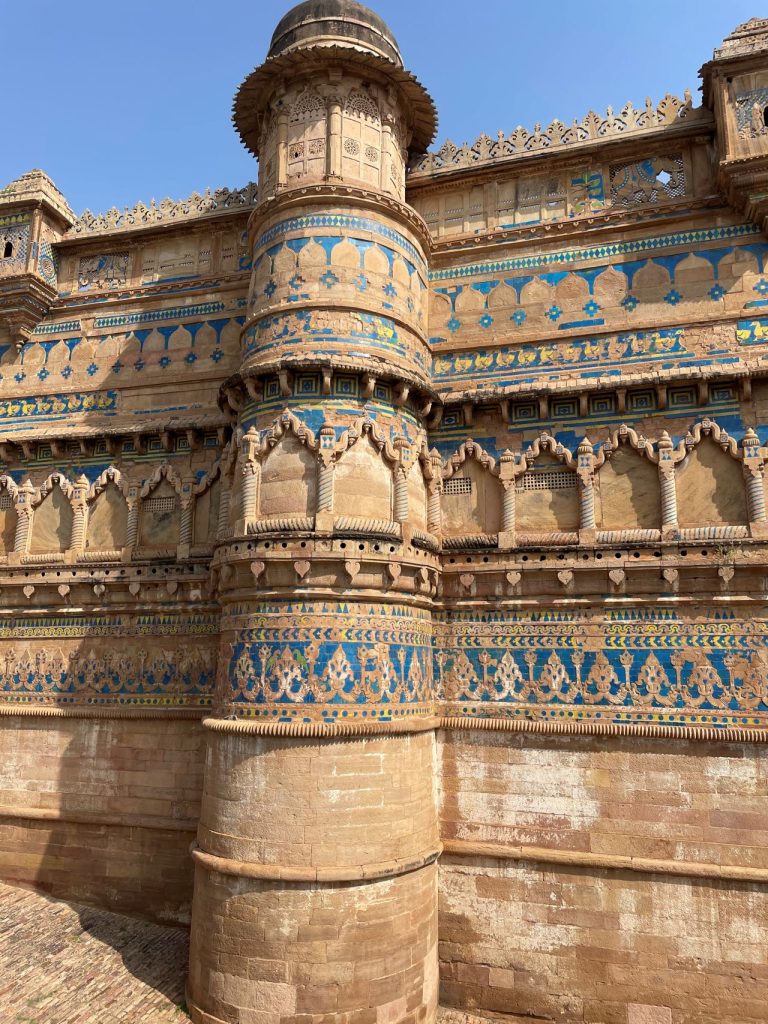
The Delhi Sultanate wielded power briefly but the Gwalior Fort as we see it today is synonymous with Raja Man Singh Tomar of the Tomar Dynasty before the Mughals took control of it. ” However the massive four-storeyed medieval fortress and palace, with a defensive structure wears the stamp of Raja Man Singh Tomar who even imported the blue glazed tiles from Persia and places like Samarkand and Bukhara as well. It is indeed the blue glazed tiles that add a special touch to the Gwalior Fort architecture.
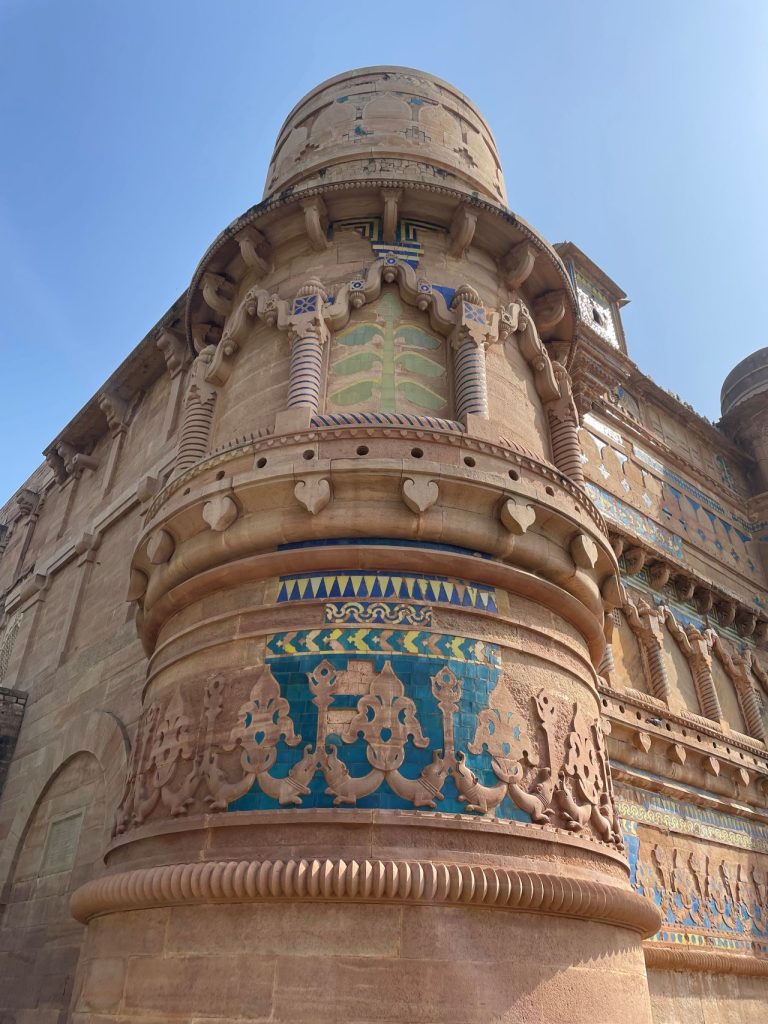
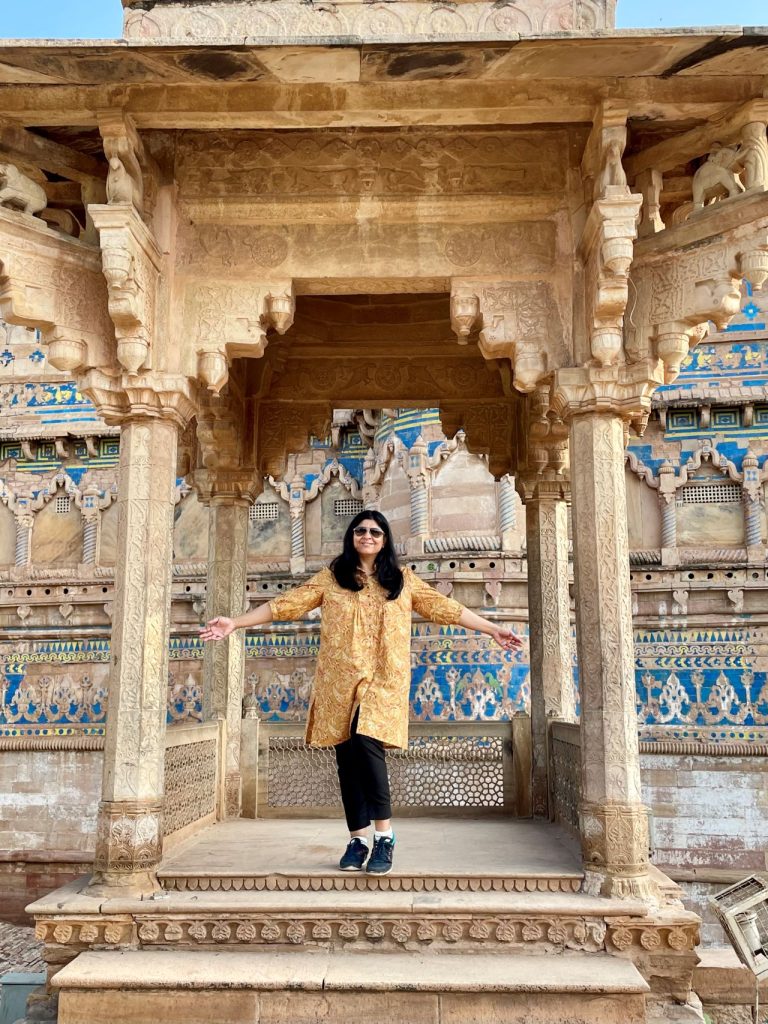
The sprawling Gwalior Fort is a virtual city in itself that it virtually dwarfs the town of Gwalior and in this sprawling complex, you will find palaces, temples, cave temples, carvings, stepwells, reservoirs, and several monuments, built by different dynasties. Dominating the entire landscape, the fortress has witnessed several historic events – be it beheadings or Jauhar. You would need at least a day to explore the various places in Gwalior Fort including the temples in Gwalior Fort.

Legend of Gwalior
According to a legend, the city is named after a hermit Gwalipa who healed a local chieftain Suraj Sen Pal of leprosy by giving him water from a sacred pond. The grateful chieftain fortified the rocky ravines around the water body and named the city Gwalior after the saint. While this legend probably dates as early as the 3rd century, historical evidence in the form of inscriptions proves that the fort existed as early as the 6th century. However, Gwalior was earlier known as Gopalkaksh, as referred to in the Mahabharat and some say that it was also called Gopadri or Gopagiri, perhaps after the Gopachal Hills, where you will find rock-cut carved Jain sculptures in the Gwalior Fort.
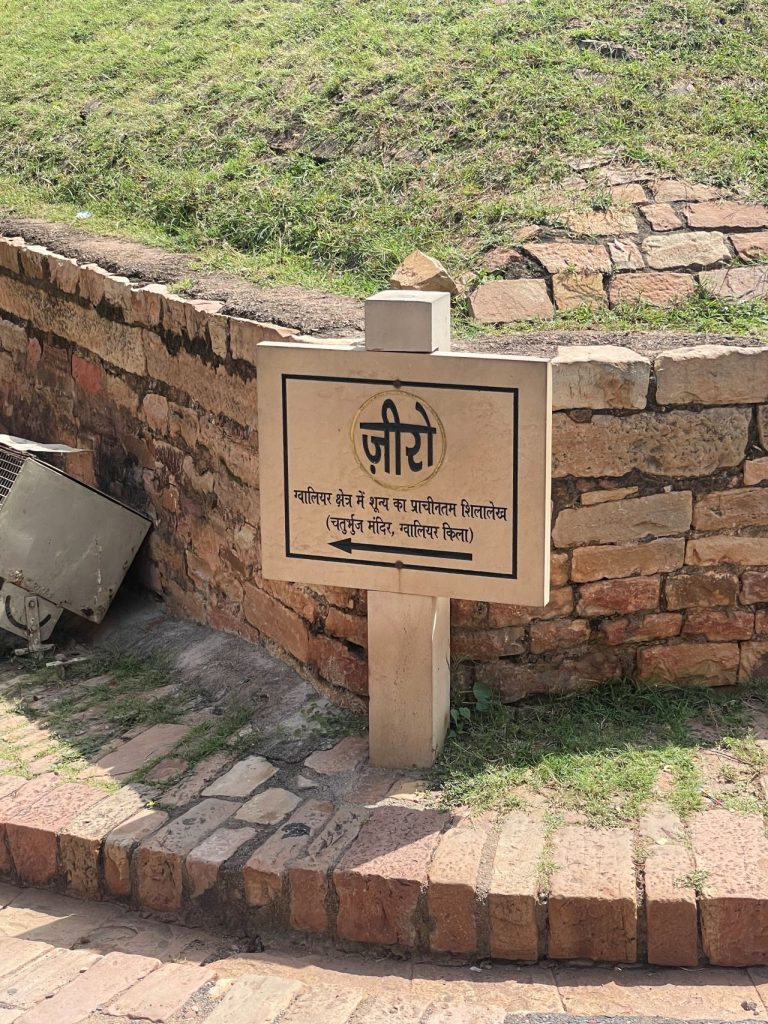
“There are two very important things about Gwalior, “This is where zero was first invented and if you go down below to the Chaturbhuj Temple, you can eve see the depiction of the same. The second thing is Gwalior’s connection to the famous Kohinoor Ratna, which was with Raja Mann Singh Tomar who built this fort and palace. He gave it to his son Vikram Singh from whom the Mughals took it. Then Nadir Shah looted it and from Persia, it travelled to London where it is showcased in the Jewel House at the Tower of London.
Gwalior Fort – Man Mandir Palace
When you think of the stunning Gwalior Fort, you don’t think of the sparkling Kohinoor Diamond but it is the glazed blue tiles adorning it that flash in your mind’s eye. Raja Man Singh Tomar Tomar who built the splendid fort and palace is synonymous with the fort complex. Built in the 15th -16th centuries with open courtyards and underground cellars, the four-storeyed palace is an architectural marvel with pillars and brackets and fascinating carvings while the blue glazed tiles add a touch of magic to the facade.
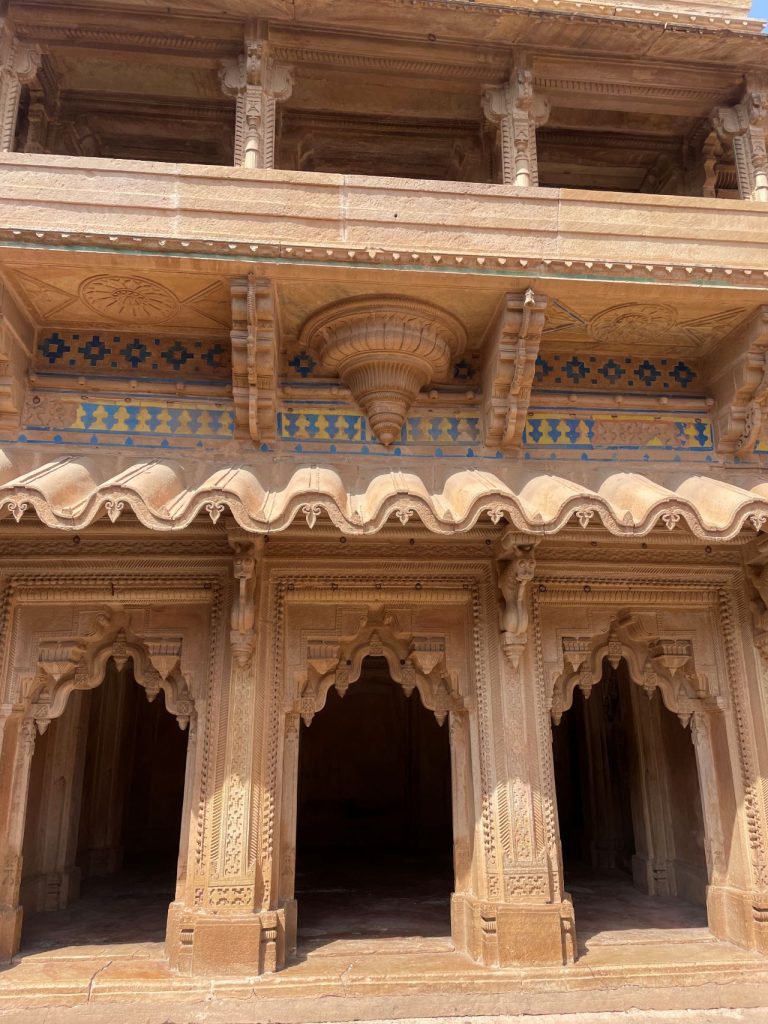
You can also see the rooms that were used as Jhula Ghar and Kesar Kunda as well, Every chamber here has its tale, especially the two underground floors, which were once used as hammams ( baths) by the queens but later turned into prisons where conspiracies were hatched and many a noble prince has been executed. History says that Mughal prince Murad was imprisoned and killed in the underground jail of the Man Mandir Palace by his brother Aurangazeb who usurped the throne.
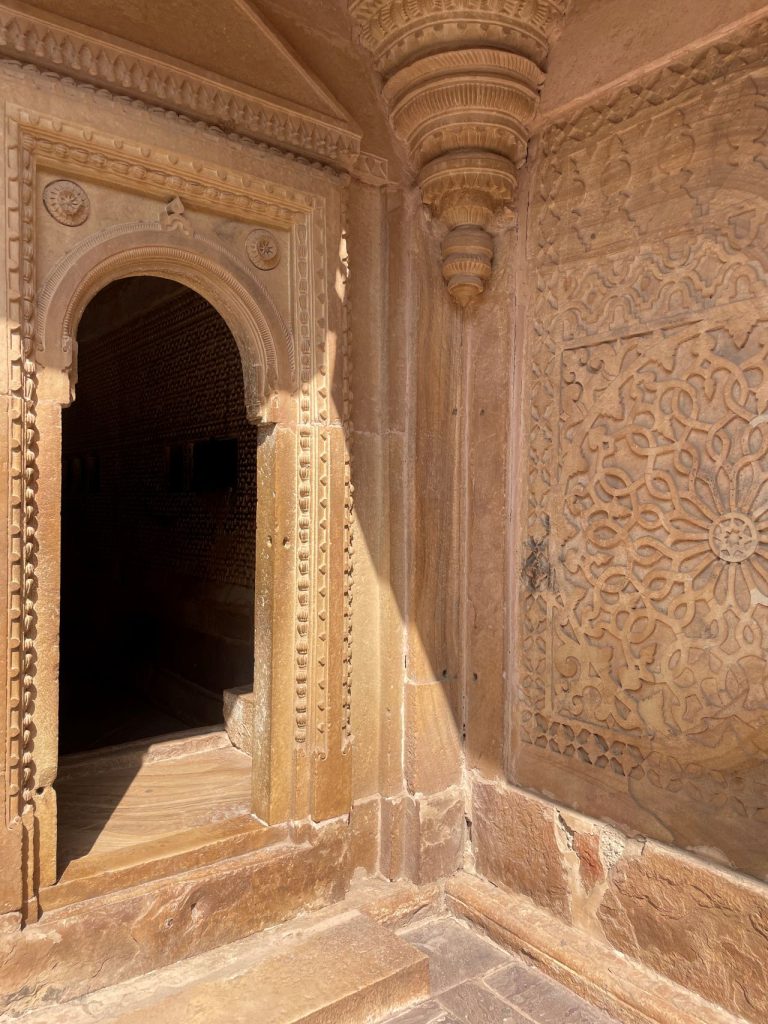
More Palaces and places in Gwalior Fort
Besides the Raja Man Singh Palace, there are two exquisite palaces – Karn Mahal, built by Kirti Singh of the Tomar Dynasty, and Vikram Mahal built by the son of Raja Maan Singh. We went on to explore two more palaces dedicated to the Mughal kings, Shah Jahan and Jahangir that were built much later. But there are many more places in Gwalior Fort than just palaces.
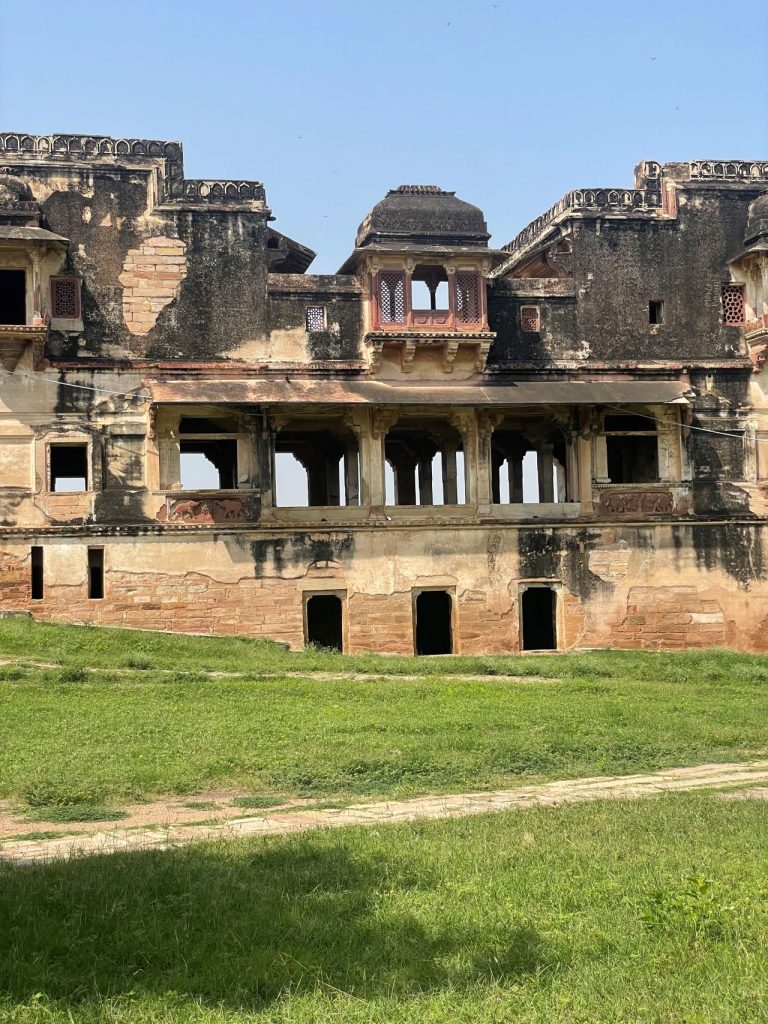
 Looking out of the Jahangir Palace we were lost in the hazy views of Gwalior town but the imposing facade of Gujri Mahal, built by Raja Maan Singh for his wife, Mrignayani stood out in the clutter.
Looking out of the Jahangir Palace we were lost in the hazy views of Gwalior town but the imposing facade of Gujri Mahal, built by Raja Maan Singh for his wife, Mrignayani stood out in the clutter.
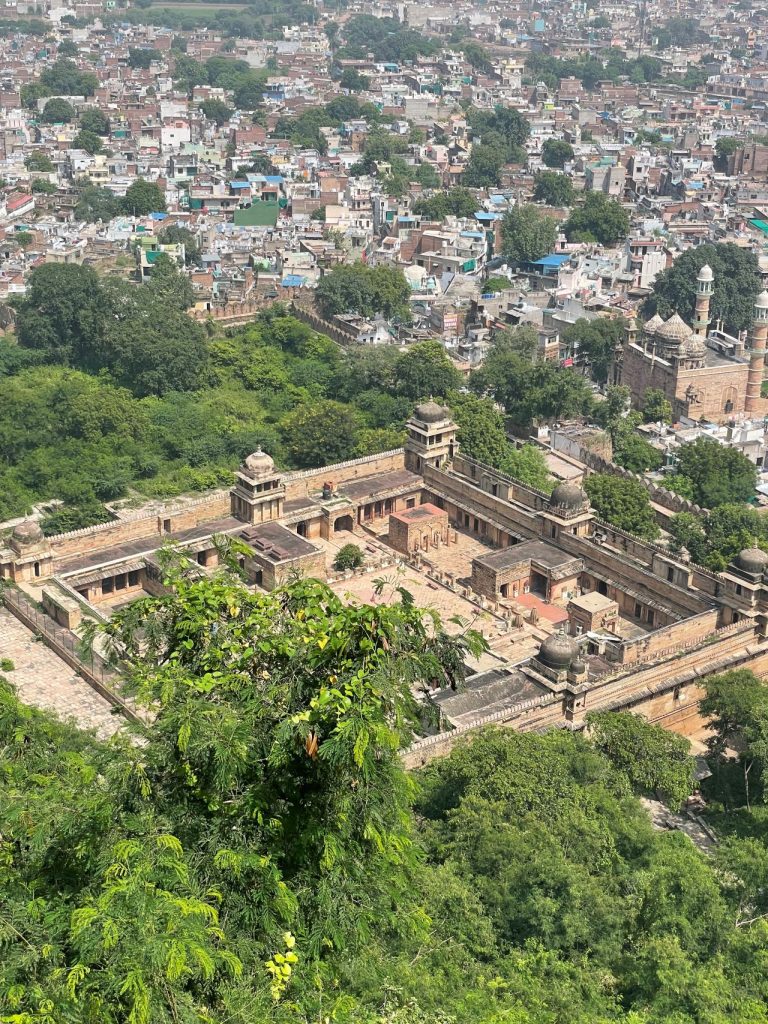
Right in the heart of the site, amidst the palaces, stood one of the largest Jauhar Kund here where scores of Rajput women committed Sati when the Delhi Sultan Iltumish invaded Gwalior.
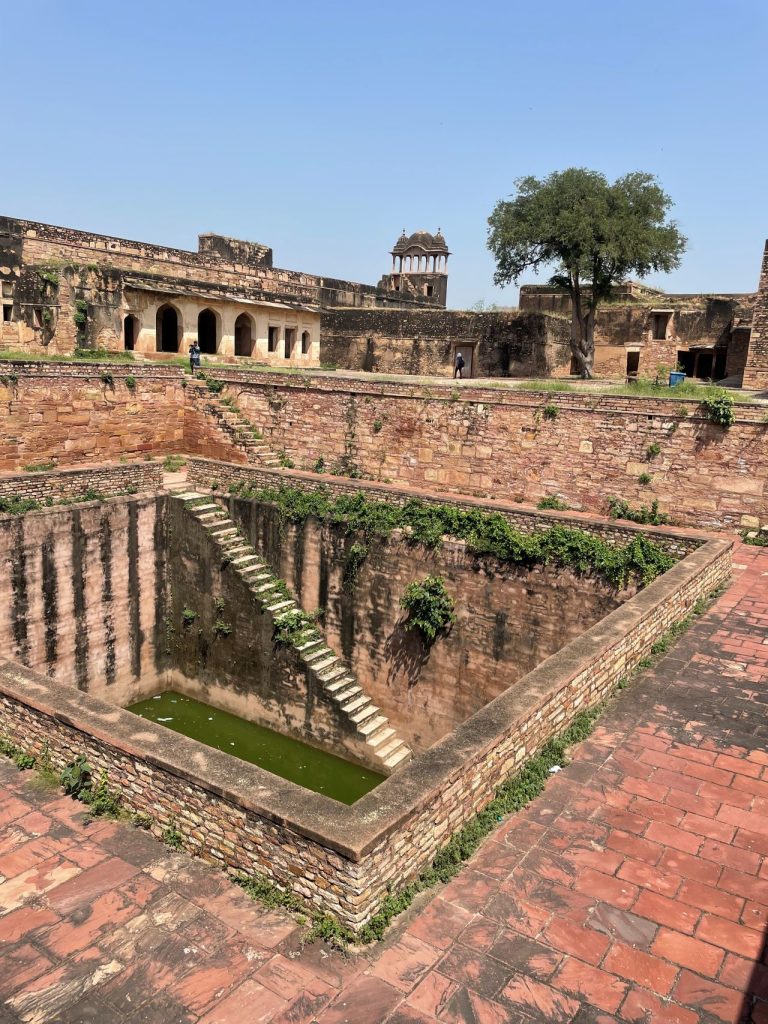
Gujari Mahal Palace
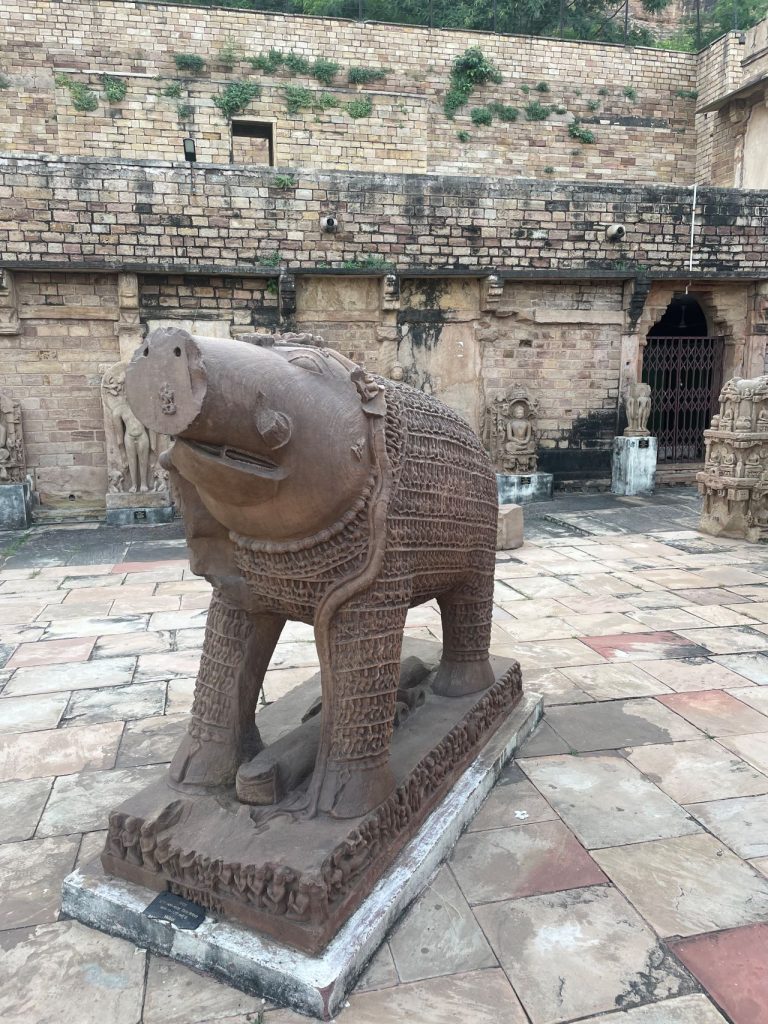
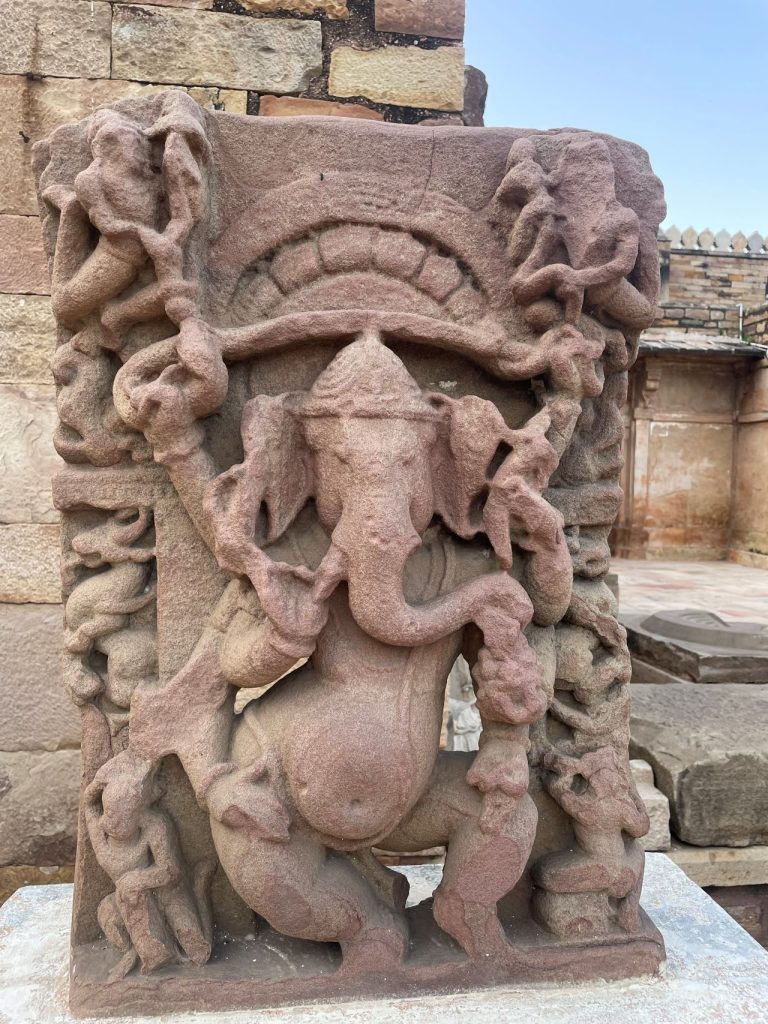
The beautiful Gujari Mahal was built by Raja Maan Singh for his wife, Mrignayani, an edifice of love. Mrignayani was a Gujjar Princess and she insisted that she had a separate palace that was also close to a water source so that she would have a perennial supply of water. Raja Mann Singh built the palace outside the complex of Gwalior Fort and you can see the view of the palace from the Jahangir Mahal.
The open-air palace courtyard is now a State Archaeological Museum and houses several beautiful excavated carvings and sculptures that are over 1000 years old. Besides the carvings, there are also miniature temples that have been brought from Bateshwar near Morena as well as in the Gujari Mahal Museum.

But the most prized possession of this museum is another beautiful woman – the gorgeous Mona Lisa of India. While I was already enamored by the Gujri Palace, after listening to the story of King Maan Singh Tomar who built the palace exclusively for his new bride, Mrignayani, I was not prepared for the beautiful carving of India’s own Mona Lisa, who is hidden in the vaults of the museum.
This beautiful woman with a mysterious smile is a carving of the lovely Salabhanjika or Shalabhanjika and is tucked away in a little room inside the Gujari Mahal Museum She is extremely beautiful and you can only get a glimpse of her from locked doors if you are lucky.
A small underground chamber has been converted into a room dedicated to music and musical instruments, where you can see an old rusty pipe which was the main water source for the palace as per the queen’s wishes.
Temples in the Gwalior Fort.
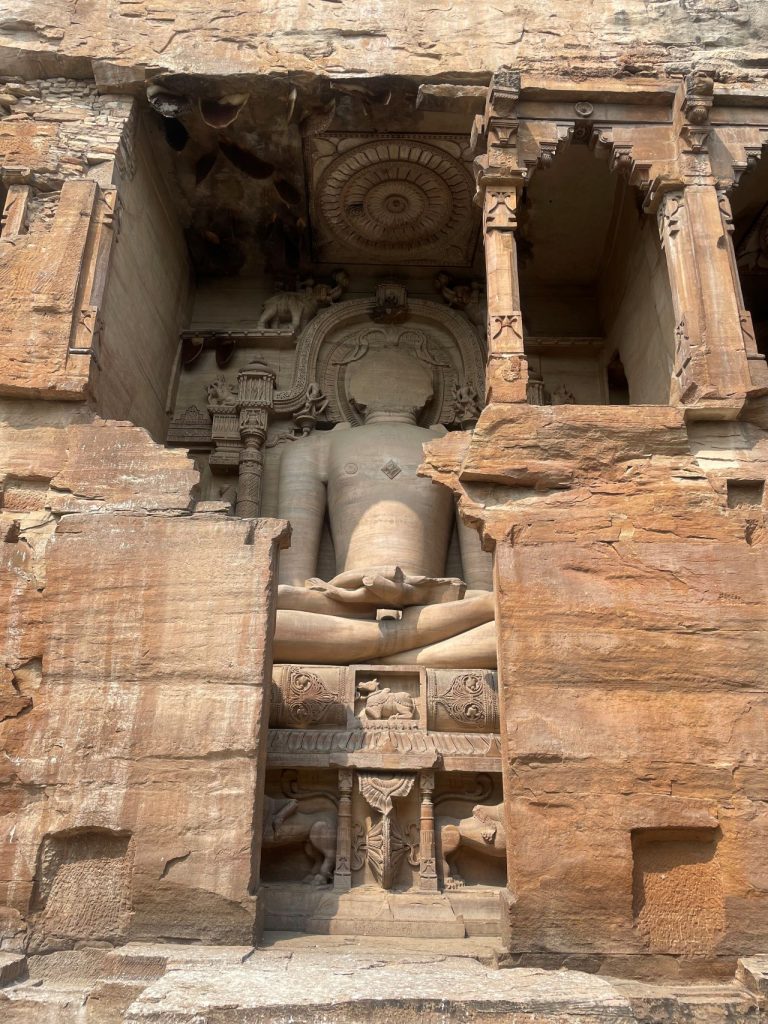
There are numerous Hindu and Jain temples inside the complex and the most important is the Chaturbhuj temple which houses the world’s oldest recorded symbol of zero.
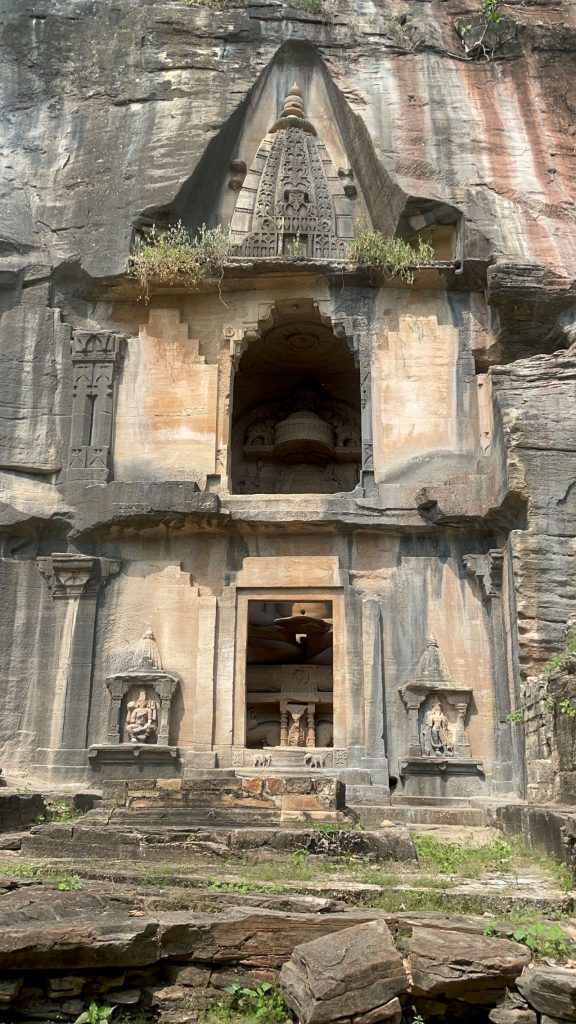
The other temples include Saas Bahu or the Sahasrabahu temple and the Teli Ka Mandir Among other aspects of the fort are the massive caves – Siddhanchal and Gopachal with the larger-than-life rock carvings of Jain Teerthankaras.
Saas Bahu Temple
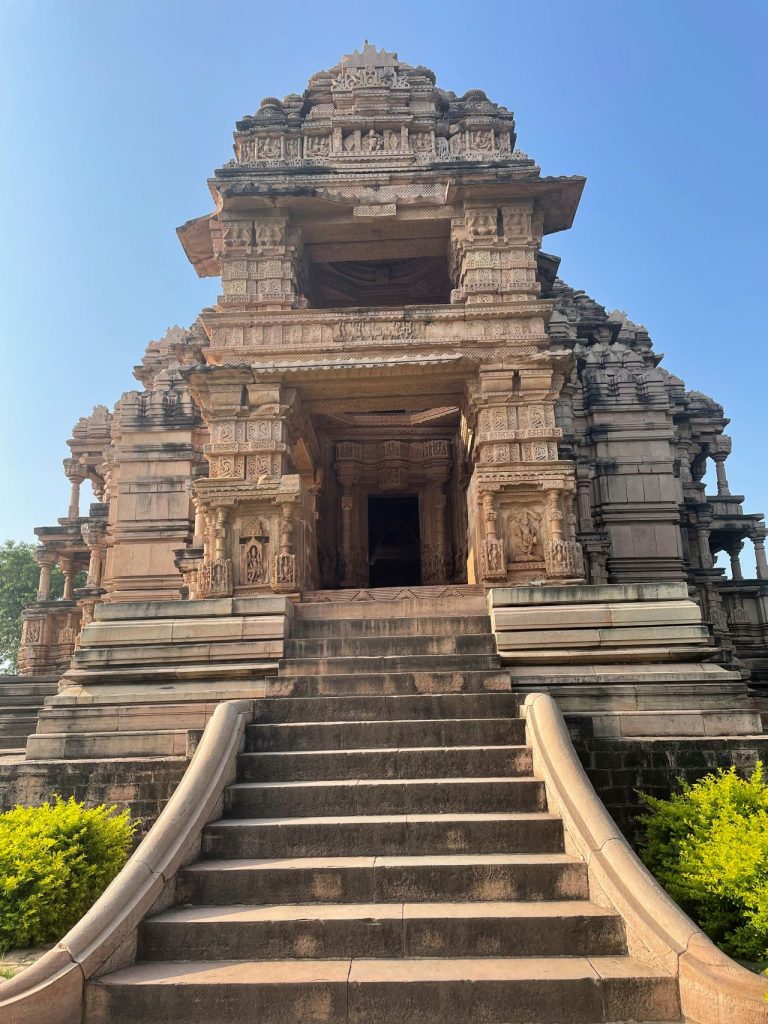
The name was intriguing but I learnt later that the Saas Bahu Temple referred to exquisite twin temples called Sahastrabahu or the Harisadanam temple dedicated to Bhagwan Vishnu and built out of sandstone in the 11th century by King Mahipala. Some legends say it is King Kirti however.
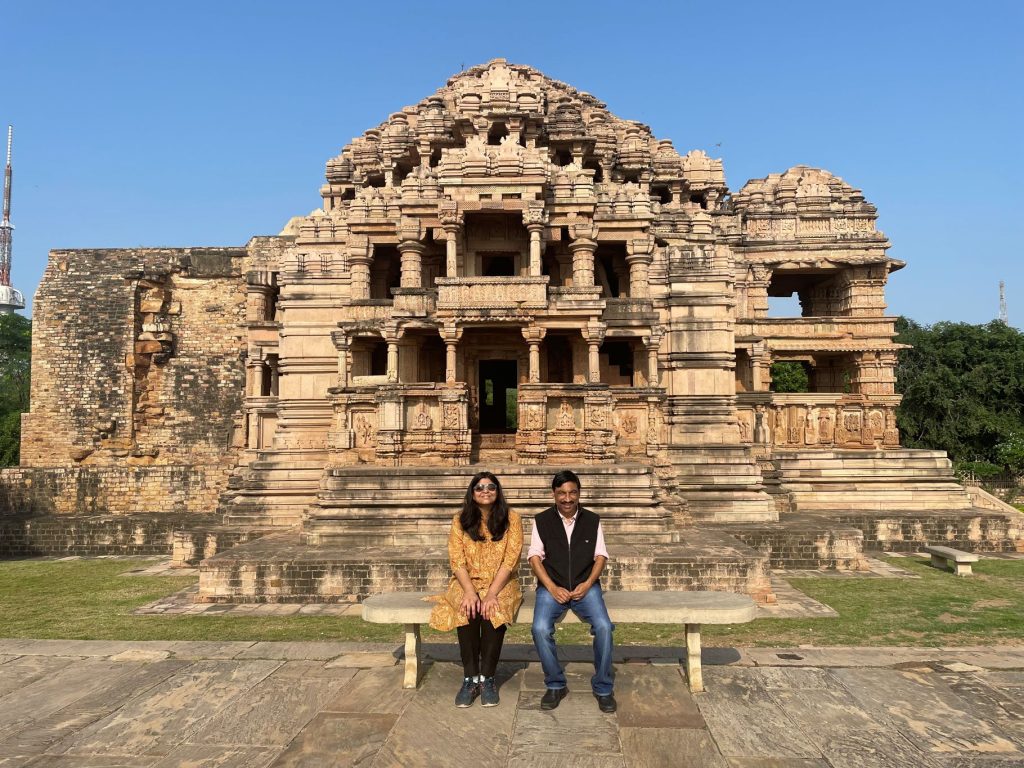
The first temple is bigger with three storeys of intricate carvings and my guide laughed saying that folklores say this was built by the king for the mother, while the second, more petite and charming was for the wife. However both the temples are sheer poetry in stone.
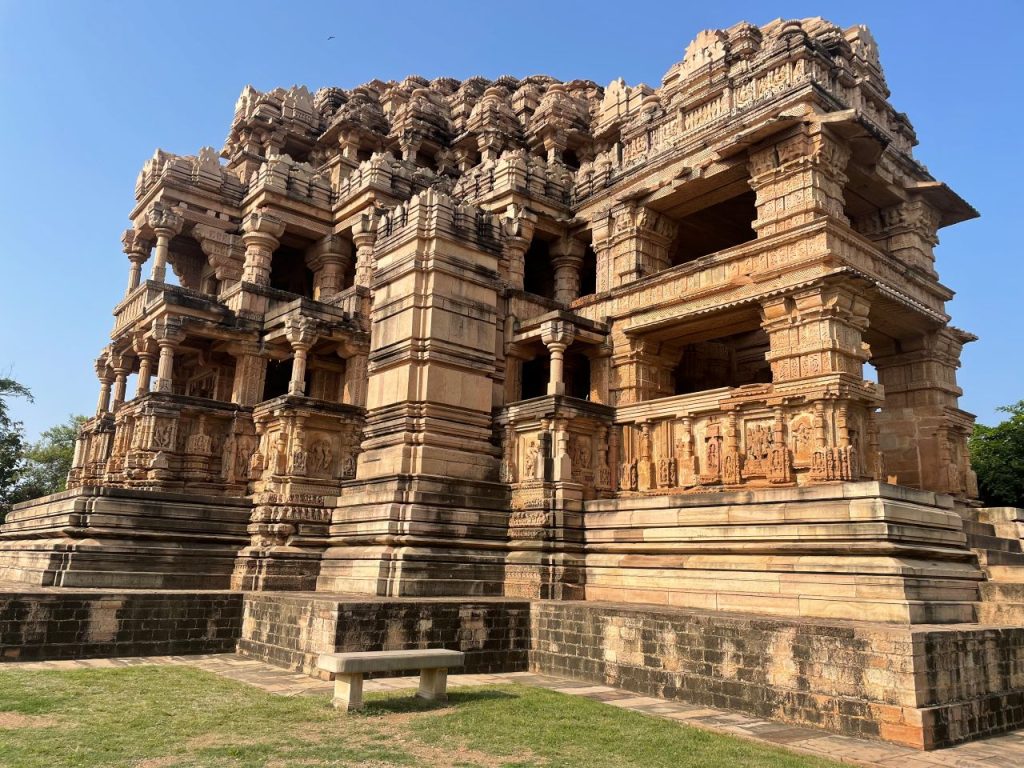
The main inner sanctum is however empty and the temples have been destroyed during the wars. You can see views of Gwalior from the smaller temple.
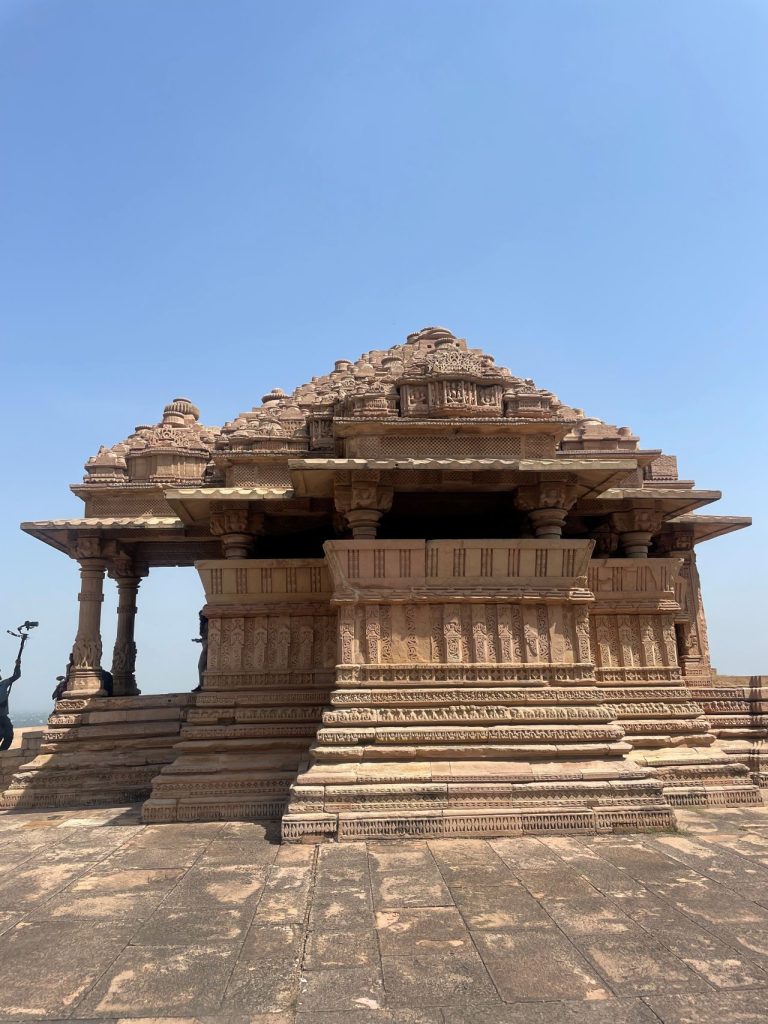
Teli Ka Mandir
Of the many temples in Gwalior Fort, this 1000-year-old Teli Ka temple, one of the oldest in the Gwalior Fort was built apparently with donations from oil merchants and has a unique style of architecture, referred to as “wagon top”. The tower soars up to over 100 feet and while there are several carvings on the outer walls, the inner sanctum is empty.
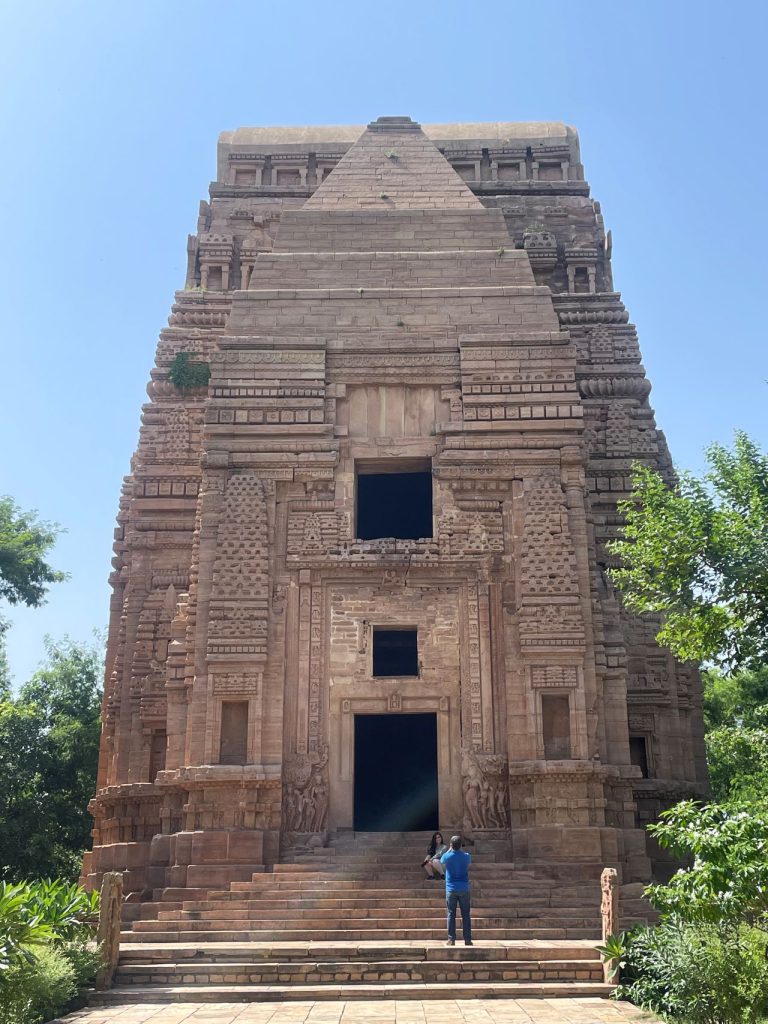
KK Muhammed Sir mentioned that it could have been dedicated to Bhagwan Maha Vishnu or the Hindu Trinity of Gods – Bhagwan Brahma, Bhagwan Vishnu, and Bhagwan Shiva. It could also be dedicated to the Navagraha, he added.
Jain Cave Temples – Siddachal and Gopachal Cave Temples
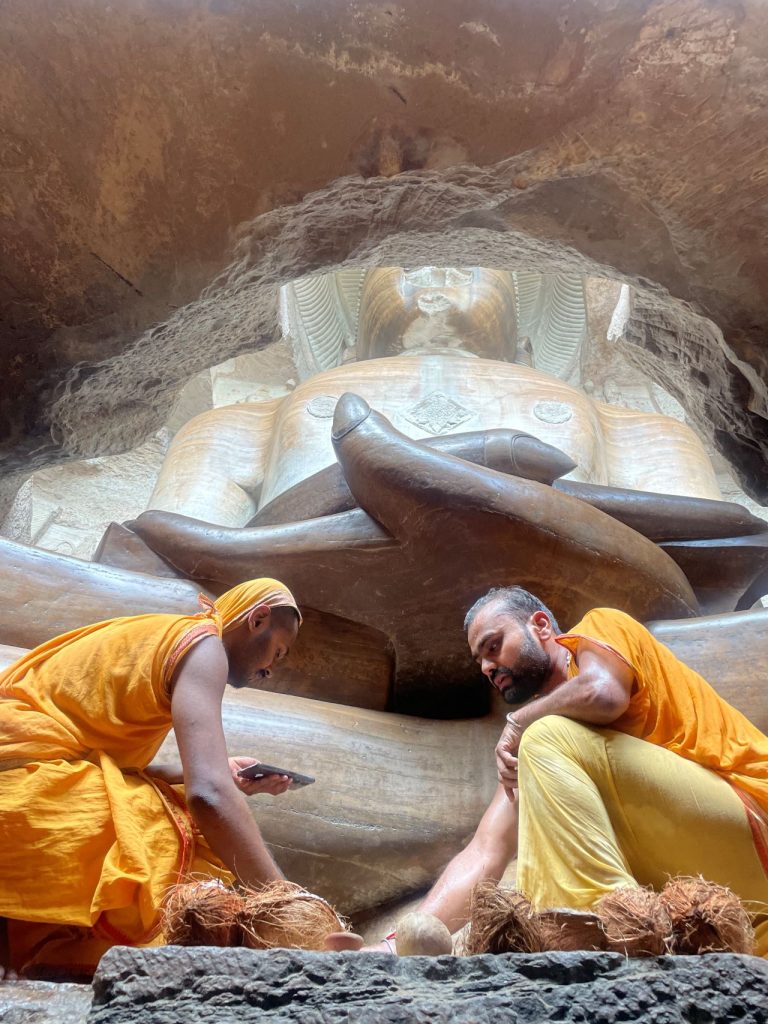
Wonders never cease in Gwalior Fort. When you think you have seen it all, you realize that everything here is larger than life.
Near the Urwai Gate on either side of the Valley are gargantuan sculptures of Teerthankaras carved on rocks, some in sitting postures while most of them are standing. We are at the Siddhachal Caves where these rock-cut carvings stare right into your eyes.
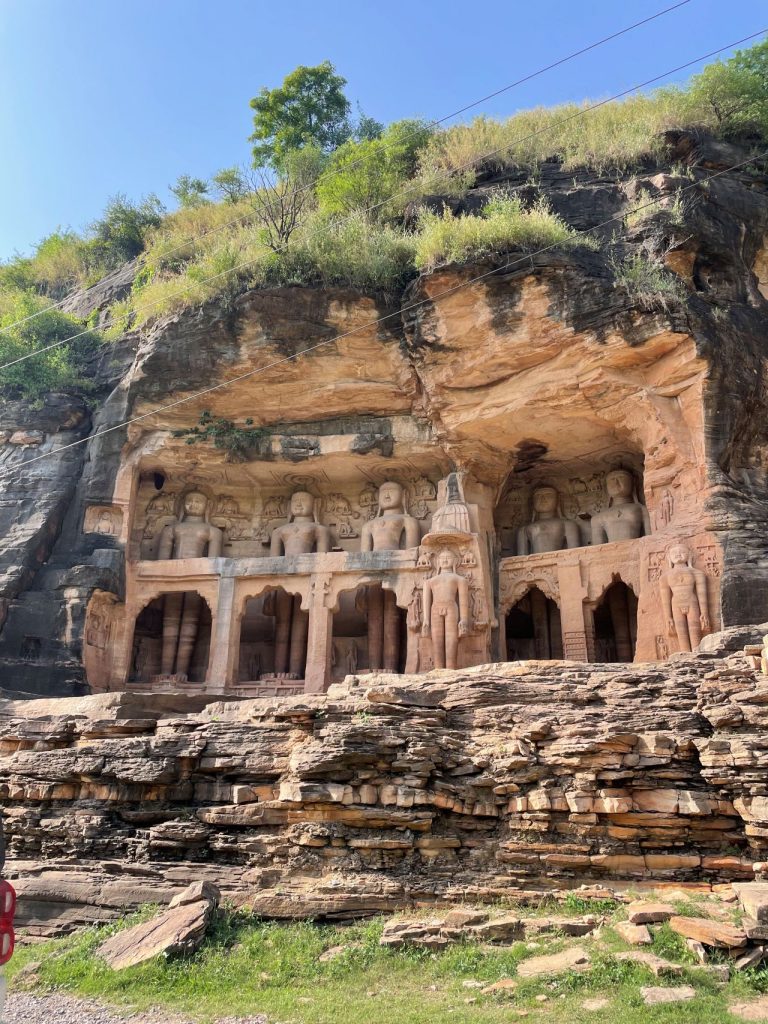
While most of the carvings are dated around the 15th century some even probably go back earlier. The largest of the Jain colossi is the 57 feet tall sculpture of Shri Adinatha while 30 feet is the sitting carving of Shri Neminatha beside other Teerthankaras.
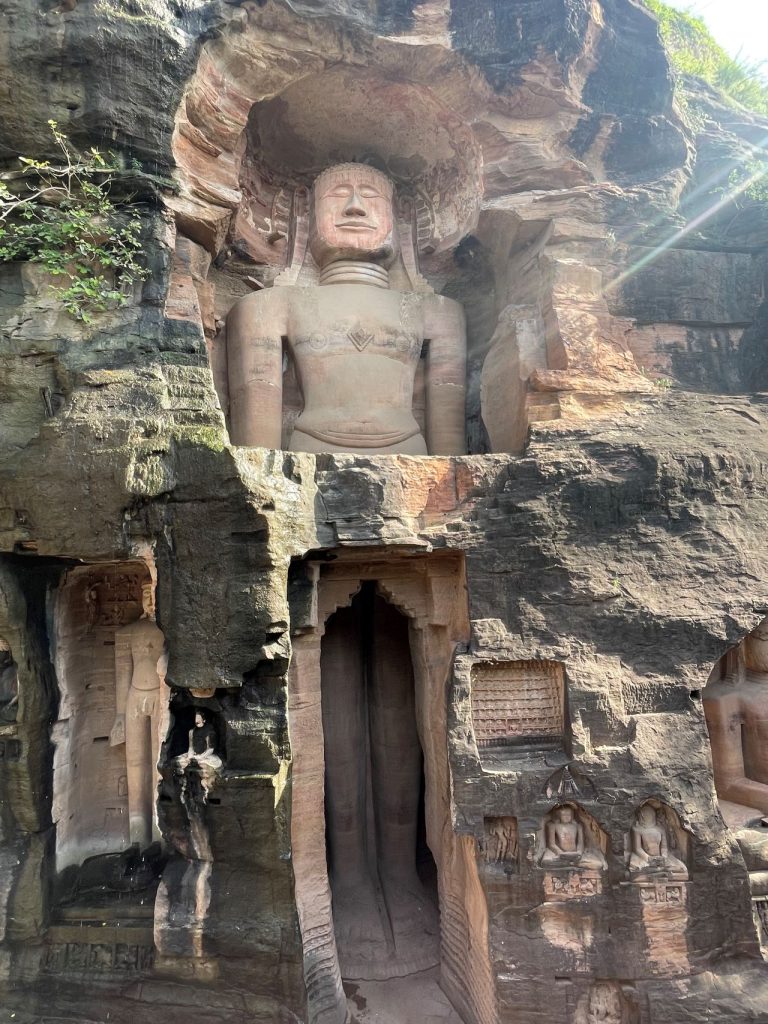
And if you thought Siddhachal Caves were mesmerizing wait until you see Gopachal on the other side with massive carvings of Jain Teerthankaras inside caves, some so dark and filled with bats. One of them fell on my arm too. We were grateful to be a part of the prayers and offerings to the massive carvings of Tirthankaras Shri Pashvanatha Ji and Sri Adinatha Ji in the Gopachal Caves. There are over 100 caves and cave temples around Gwalior
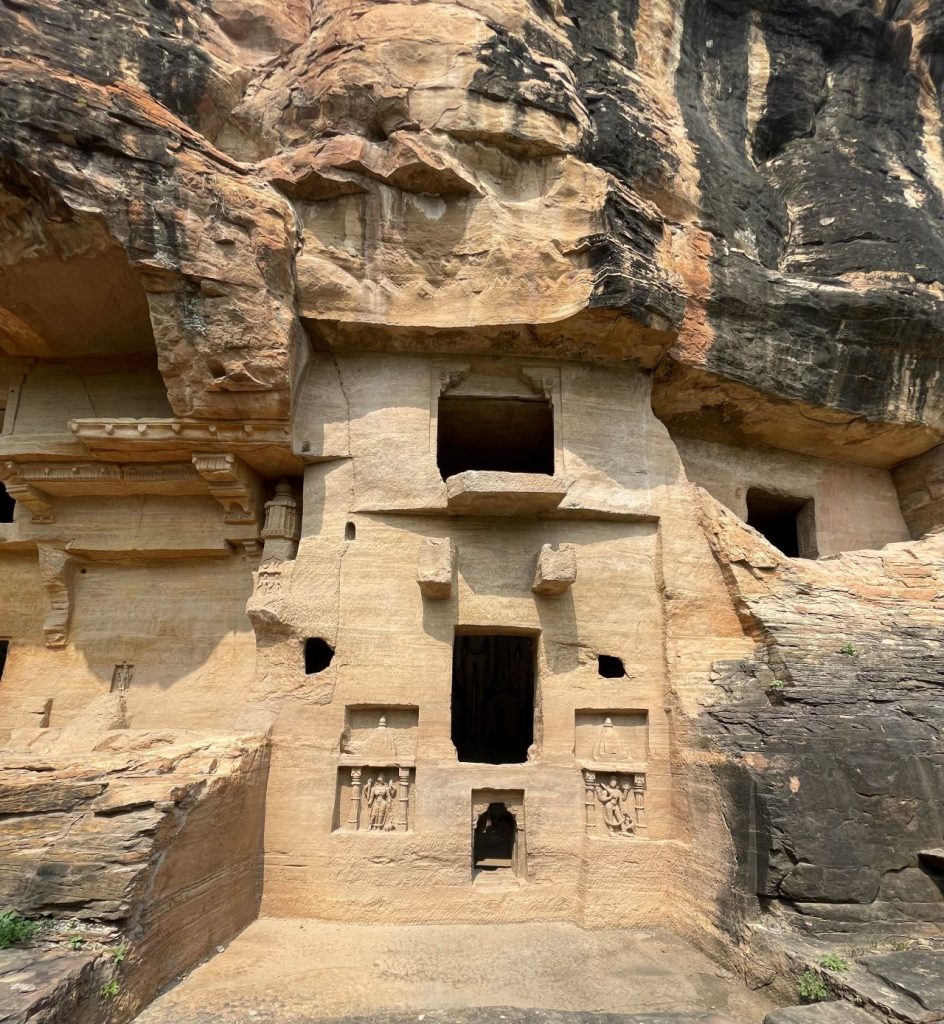
The Mughal King Babar tried to destroy and deface the carvings but that’s all he could manage. These Jain colossi have withstood the ravages of time and mesmerized you with their craftsmanship.
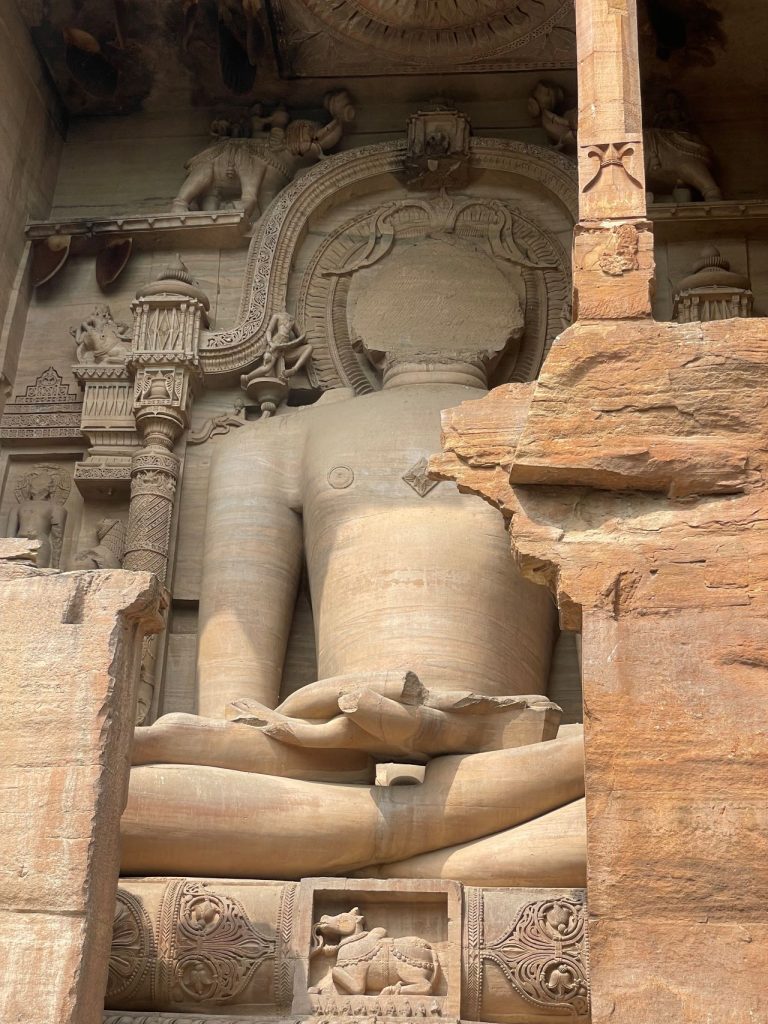
Other monuments inside the Gwalior Fort
Beyond temples and palaces, the fortress is also home to a few unique monuments like the Assi Khamba ki Baori, a stepwell with 80 pillars that stands right on the way to the palace which was built apparently by Raja Maan Singh as well.
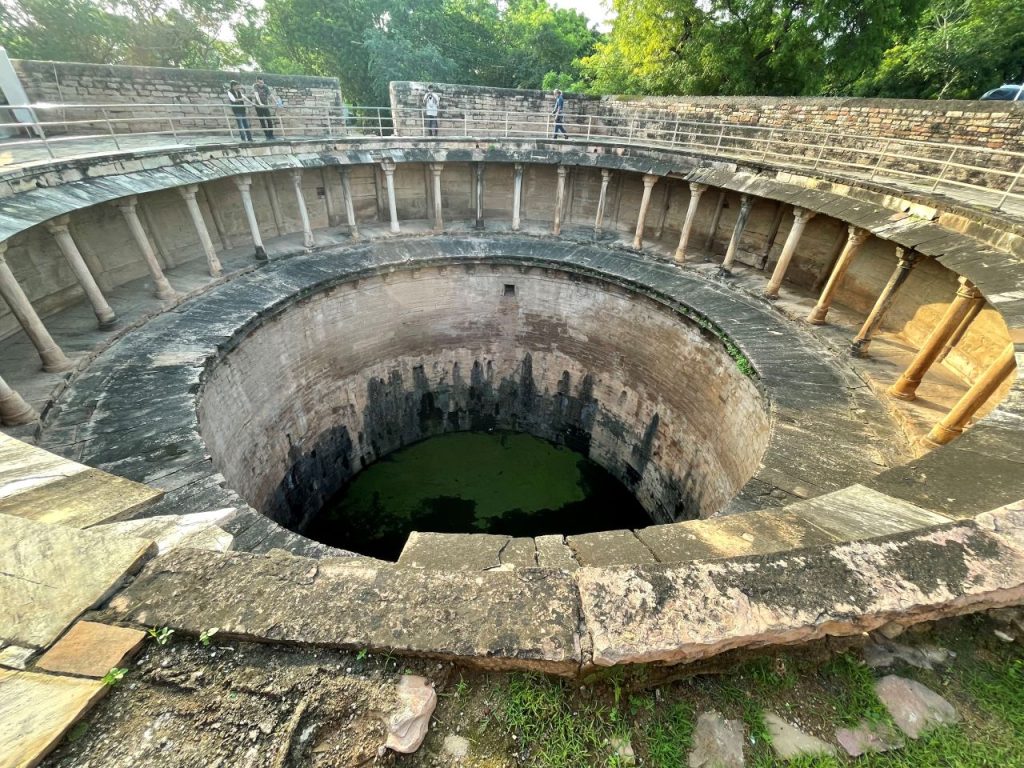
In addition, there is the Bhim Singh Rana Ki Chhatri, the Jauhar Kund in front of it, where the queens along with other women committed Sati (self-immolation) to avoid capture and a Gurudwara dedicated to the 6th Guru Hargobind Sahib Ji who was imprisoned along with 52 kings. According to the legend, Jahangir decided to liberate the Guruji who insisted that even the kings should be let free as well.
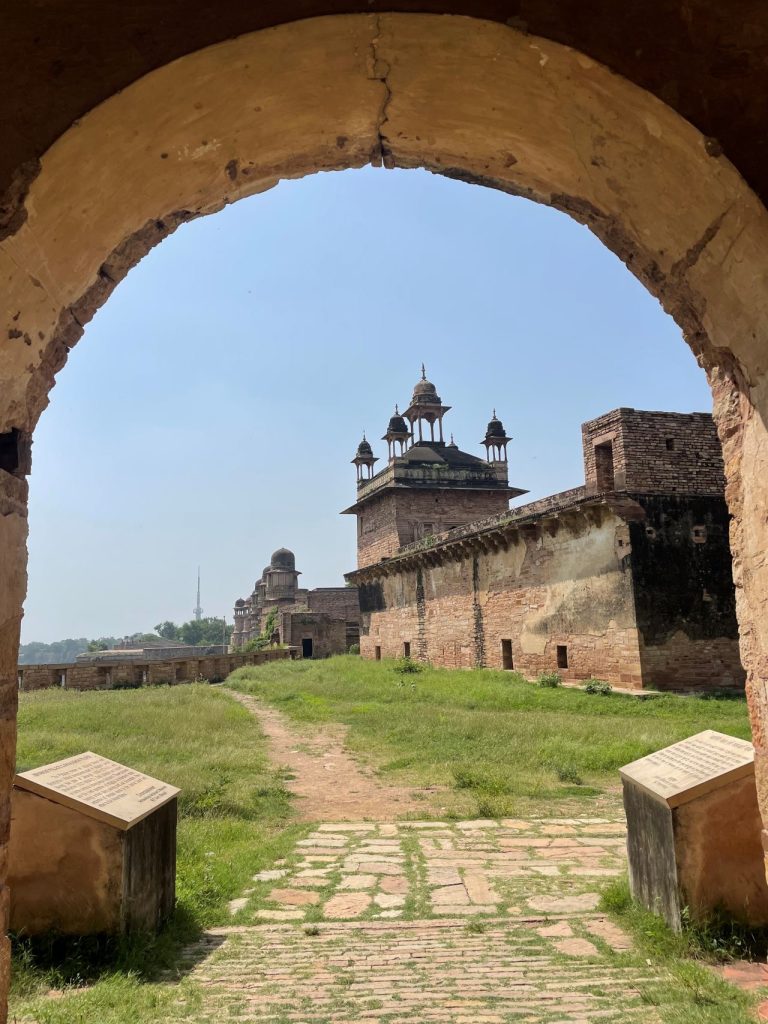
Monuments outside the Gwalior Fort
While the Gwalior Fort dominates the entire city, a visit to Gwalior is not complete if you don’t see the Jai Vilas Palace which now hosts the Jiwajirao Scindia Museum. A 19th-century palace, it takes its inspiration from European styles of architecture – the first storey is Tuscan, the second Italian-Doric and the third Corinthian. Spread over an area of 124,771 sq feet, the mammoth palace stands in Gwalior town and is a residence to some of the royal members of the Scindia family. There is a room inside the museum, dedicated to the late Madhav Rao Scindia as well as other rooms used by the royal family.
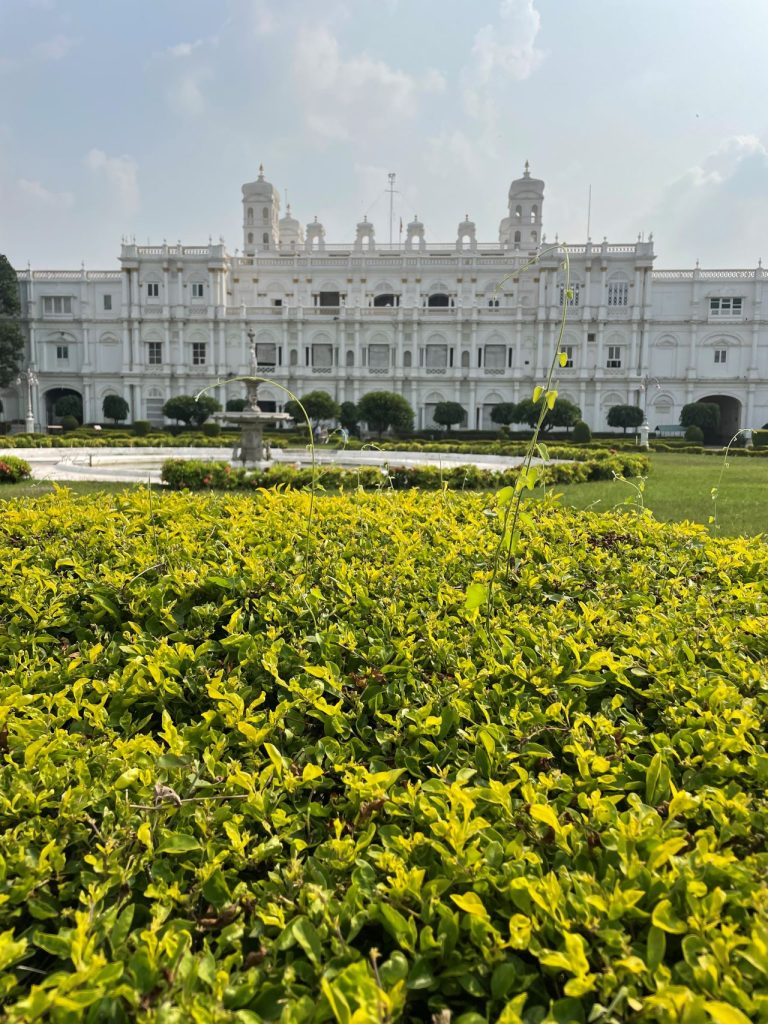
Amidst the various temples, do not miss the iconic Sun Temple in the city, located near the Gwalior Fort. The city also has a memorial built for the courageous Rani Laxmi Bai.
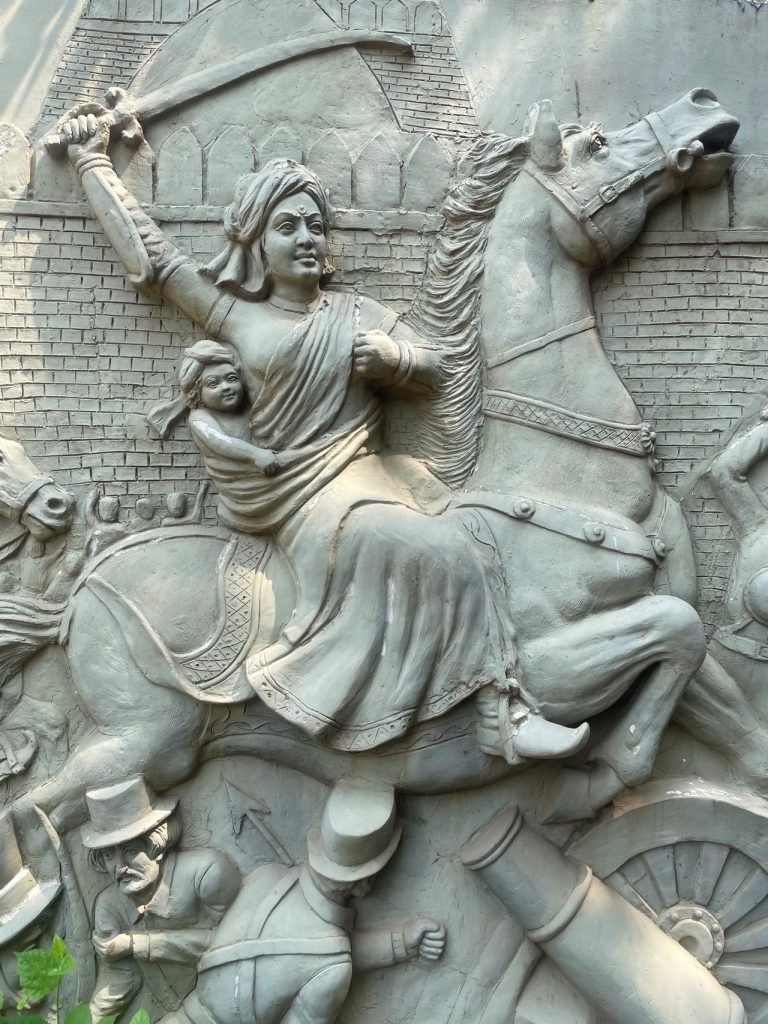
Sarod Ghar is a museum of music and musical instruments besides highlights the lives of the musicians who were from Gwalior. There is also a section paying tribute to Maestro Amjad Ali Khan.
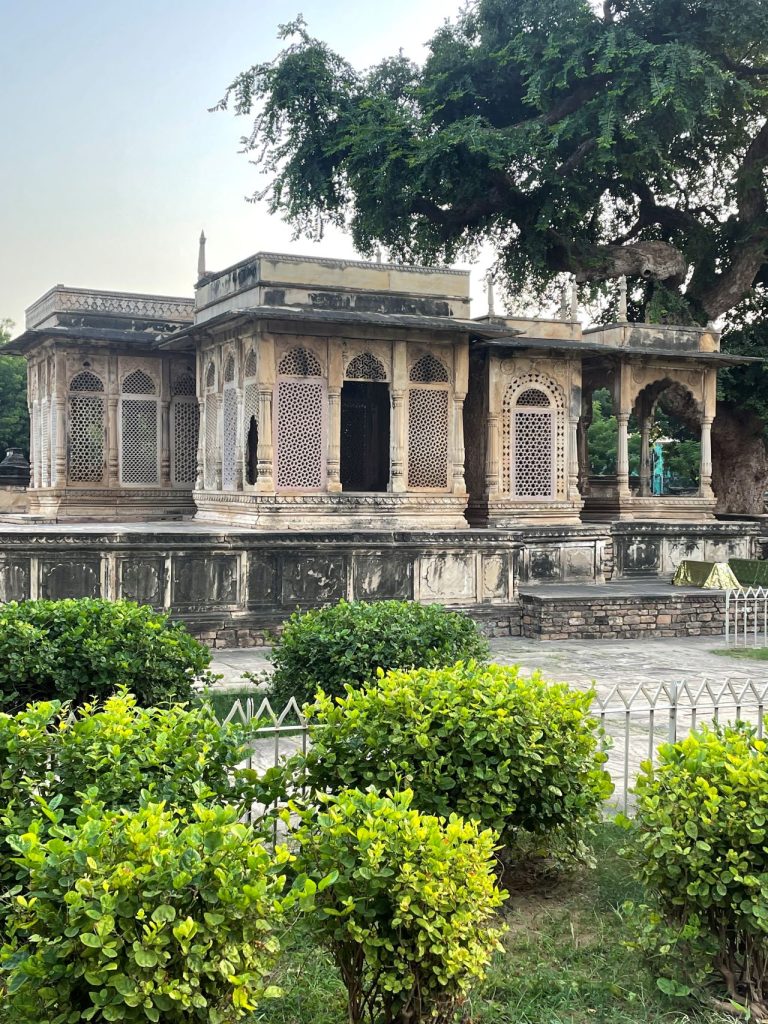
Before you leave the city of music, pay your respects at Tansen’s Tomb and at the Tomb of Muhammad Ghaus.

And my personal favourite is Maharaj Bada, also called Jayaaji Chowk, a large square right in the heart of the city, modelled on squares in Europe, which has buildings inspired by architectural styles worldwide. At night, the entire place comes alive with hawkers and markets, while the monuments are lit. Baija Taal is another serene water body in the city centre and it is heavenly to listen to strains of classical music by the lakeside.
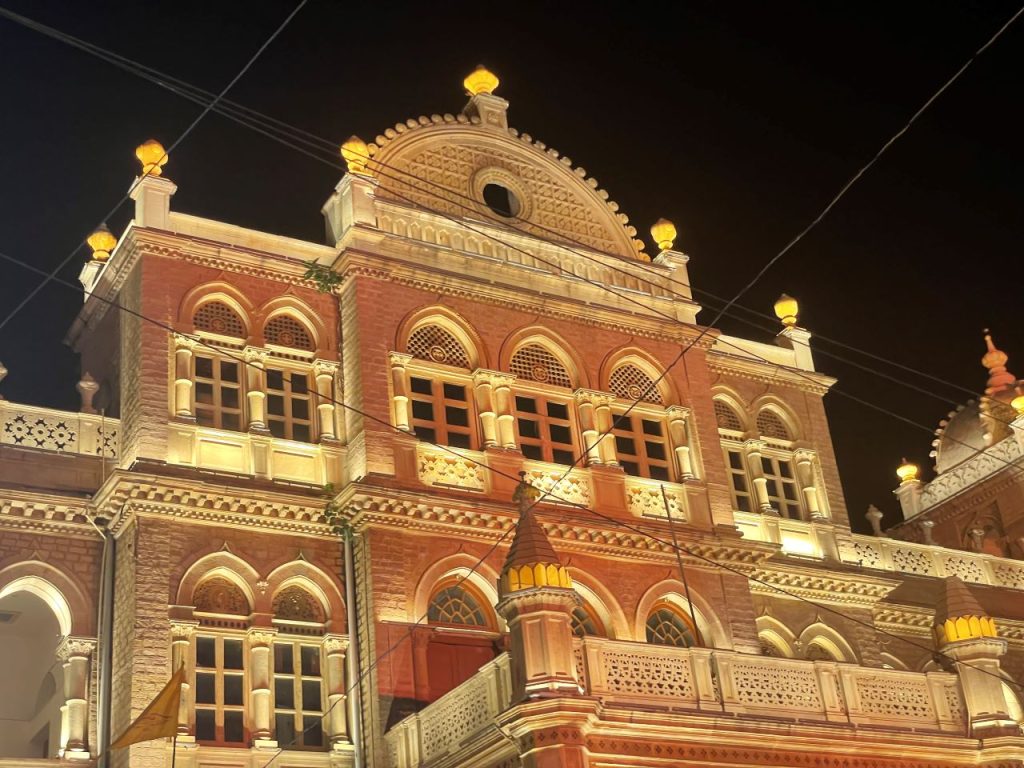
Have you been to Gwalior Fort? Do share your experiences and add any recommendations as well.

